What's New
Displaying results 3771 - 3780 of 4052
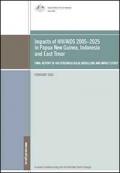
Resource | Publications,
The HIV Epidemiological Modelling and Impact (HEMI) Study was commissioned by the Australian Government for the Governments of Papua New Guinea (PNG), Indonesia and East Timor. The research was conducted by New South Global Pty Limited in 2005.
An epidemiological model was developed to project the future course of the HIV epidemic over the period 2005–2025 in PNG, Indonesia and East Timor under three scenarios. The first scenario assumed that HIV interventions remain at current levels (baseline scenario). The second and third scenarios assumed increases in HIV interventions to medium and high response levels.
Projections of HIV case numbers and deaths were used as a basis to estimate future social, economic and security impacts.
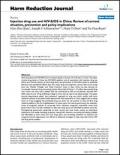
Resource | Publications,
Illicit drug abuse and HIV/AIDS have increased rapidly in the past 10 to 20 years in China. This paper reviews drug abuse in China, the HIV/AIDS epidemic and its association with injection drug use (IDU), and Chinese policies on illicit drug abuse and prevention of HIV/AIDS based on published literature and unpublished official data.
As a major drug trans-shipment country with source drugs from the "Golden Triangle" and "Gold Crescent" areas in Asia, China has also become an increasingly important drug consuming market. About half of China's 1.14 million documented drug users inject, and many share needles. IDU has contributed to 42% of cumulatively reported HIV/AIDS cases thus far. Drug trafficking is illegal in China and can lead to the death penalty. The public security departments adopt "zero tolerance" approach to drug use, which conflict with harm reduction policies of the public health departments. Past experience in China suggests that cracking down on drug smuggling and prohibiting drug use alone can not prevent or solve all illicit drug related problems in the era of globalization. In recent years, the central government has outlined a series of pragmatic policies to encourage harm reduction programs; meanwhile, some local governments have not fully mobilized to deal with drug abuse and HIV/AIDS problems seriously. Strengthening government leadership at both central and local levels; scaling up methadone substitution and needle exchange programs; making HIV voluntary counseling and testing available and affordable to both urban and rural drug users; and increasing utilization of outreach and non-governmental organizations are offered as additional strategies to help cope with China's HIV and drug abuse problem.
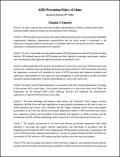
Resource | Laws and Policies,
In order to prevent and control the incidence and prevalence of AIDS, to protect human health and public health, infectious disease law, the enactment of this Ordinance.
AIDS prevention put prevention first and combine prevention policy, the government established organizational leadership, departmental responsibilities and the whole society to participate in the mechanism, strengthen publicity and education to undertake behaviour intervention and rescue measures Implement a comprehensive prevention and treatment.
No unit or individual may discriminate against HIV-infected persons and AIDS patients and their families. HIV-infected persons and AIDS patients and their families in marriage, employment, medical care, schooling and other legitimate rights and interests are protected by law.
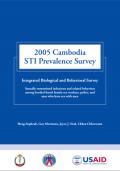
Resource | Publications,
The 2005 Sexually Transmitted Infection (STI) Prevalence Survey is the third of its kind in Cambodia.
The objectives of this survey were:
- to estimate the prevalence of gonorrhea, chlamydia, syphilis, and related risk behaviors among three sentinel groups;
- to estimate HIV among men who have sex with men (MSM); and
- to provide data for planning and management of sexually transmitted infection (STI) control and prevention programs.
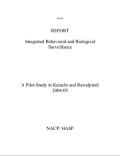
Integrated Behavioral and Biological Surveillance: A Pilot Study in Karachi and Rawalpindi 2004-2005
Resource | Publications,
Integrated Behavioral and Biological Surveillance (IBBS) uses special tools and methodologies for collecting complex behaviors of high-risk groups of HIV/AIDS. National AIDS Control Programme (NACP) along with HIV/AIDS Surveillance Project (HASP) conducted a pilot survey in Karachi and Rawalpindi to test various tools for IBBS and to determine status and variations of behaviors (unsafe sex and injecting drugs) followed by programmatic recommendations for addressing the current HIV epidemic in Pakistan.
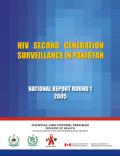
Resource | Publications,
In 2005, a rapid geographically specific mapping study was conducted in eight cities of Pakistan to estimate the size, location and operation typologies of four key sub-populations: female sex workers (FSWs), male sex workers (MSWs) Hijra or transgender sex workers (HSWs) and injecting drug users (IDUs). The eight selected cities were Karachi, Lahore, Faisalabad, Multan, Hyderabad, Sukkur, Peshawar, and Quetta.
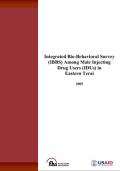
Resource | Publications,
HIV transmission among drug users is associated with injecting drug use that involves the sharing of needles or syringes. Risky sexual behavior associated with drug use also contributes to the spread of HIV. Injecting drug users function as a “bridging population” for HIV transmission between a core HIV risk group, other high-risk groups, and the general population. The main objective of this study was to estimate the prevalence rate of HIV among injecting drug users (IDUs) and assess their risky behavior. The study was conducted in among IDUs in the sub-metropolitan city and municipalities, and the highway areas of Jhapa, Sunsari, and Morang districts of the Eastern Terai.
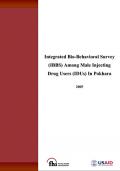
Resource | Publications,
HIV transmission among drug users is associated with injecting drug use that involves the sharing of needles or syringes. Risky sexual behavior associated with drug use also contributes to the spread of HIV. Injecting drug users function as a “bridging population” for HIV transmission between a core HIV risk group, other high-risk groups, and the general population. The main objective of this study was to estimate the prevalence rate of HIV among injecting drug users (IDUs) and assess their risky behavior. The study was conducted in the Pokhara Valley. Three hundred male IDUs were sampled using the respondent-driven sampling (RDS) methodology.
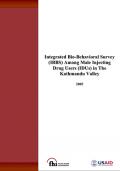
Resource | Publications,
HIV transmission among drug users is associated with injecting drug use that involves the sharing of needles or syringes. Risky sexual behavior associated with drug use also contributes to the spread of HIV. Injecting drug users function as a “bridging population” for HIV transmission between a core HIV risk group, other high-risk groups, and the general population. The main objective of this study was to estimate the prevalence rate of HIV among injecting drug users (IDUs) and assess their risky behavior. The study was conducted in the Kathmandu Valley. Three hundred male IDUs were sampled using the respondent driven sampling (RDS) methodology.
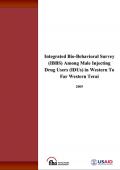
Resource | Publications,
HIV transmission among drug users is associated with injecting drug use that involves the sharing of needles or syringes. Risky sexual behavior associated with drug use also contributes to the spread of HIV. Injecting drug users function as a “bridging population” for HIV transmission between a core HIV risk group, other high-risk groups, and the general population. The main objective of this study was to estimate the prevalence rate of HIV among injecting drug users (IDUs) and assess their risky behavior. The study was conducted among IDUs in the municipalities and highway areas of Rupandehi, Banke, Kailali, and Kanchanpur districts of the Western to Far Western Terai. Three hundred male IDUs were sampled using the respondent driven sampling (RDS) methodology.





